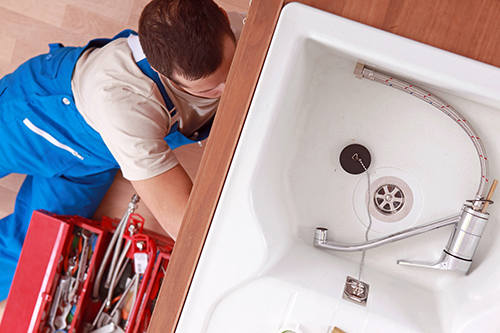
If you aren’t excited about plumbing because it seems like a dangerous or unsanitary task, then you’re not alone. Fortunately, there are some plumbing basics you can learn to safely handle minor repairs. Doing these basic tasks on your own will not only save you money; but they will also help you fix small problems before they become major issues. This guide to plumbing basics should help you get started.
Basic Tools
There are certain basic tools every homeowner should have on hand for minor repairs. When it comes to plumbing, the tools aren’t particularly expensive, although some are a bit specialized. Here’s a list of basic plumbing tools you should have on hand.
- Locking Pliers or an Adjustable Wrench. This tool will help you change a faucet or showerhead effectively.
- Needle-Nosed Pliers. With plumbing you’re often working in tight places, so a set of needle-nosed pliers will be very helpful. You can get a grip on very small parts with these.
- Plumber’s Tape. Plumber’s tape is great for those times when you want to avoid having your tightened plumbing joints leak water everywhere…which is always.
- Plumber’s Putty. Similar to plumber’s tape, plumber’s putty will help you create a water-resistant seal on non-pressurized plumbing joints like sink drains.
- Wrench. When the pliers can’t get ahold of the part you need, a trusty wrench will be able to give you access to hard-to-reach joints.
- Caulk Gun with Caulk. Caulk allows you to create a water-tight seal, which is important when installing sinks, tile, or repairing seams in the bathroom.
Location of Shut Off Valves and Electricity Breakers
As you learn plumbing basics, the first thing you need to be aware of is the location of shut-off valves and electricity breakers. There’s nothing worse than a minor repair that turns into an emergency because you forgot to turn off the water supply to the pipe that you were working on.
Most plumbing shut off valves are located individually near the sink or toilet in question. They are often rotating knobs that, when turned fully one direction, are fully on and when turned the other direction they’re off. The picture below shows two water shut-off valves under a kitchen sink.
Courtesy of Wikimedia
In addition to water shut-off valves, basic plumbing repairs may require you to turn off power to the appliance. For example, if you’re working on a clogged garbage disposal, you’ll need to turn it off and cut the power. This can be done by locating your breaker box and turning off the breaker that supplies power to that appliance. There may also be a power shut-off switch near the appliance itself.
The Four Most Common DIY Plumbing Jobs
When learning plumbing basics, you’ll find that you tend to encounter certain types of jobs more often than others. These are the most common types of repairs and installations you will face, so they should form the foundation of your plumbing basics education. Here are the four most common DIY plumbing jobs.
- Unclogging a drain. Whether it’s the kitchen sink, toilet, or bathtub, unclogging drains is one of the most common DIY plumbing repairs. It’s important to know what tools to use and how – chemical drain openers are not always the solution, and you’ll need a different type of plunger for the sink than the toilet.
- Changing Faucets or Showerheads. Alright! You got that great new massaging shower head for your birthday. Do you know how to put it on? A strong arm, adjustable wrench, and plumbing tape will help you get the job done.
- Drain and Flush the Water Heater. Part of learning plumbing basics is learning how to maintain your appliances before there’s a problem. When you drain and flush your water heater every year, you’ll extend its life and save yourself both time and money.
- Replacing Leaky Supply Lines. Knowing how to replace braided stainless steel supply lines on your sinks, toilets, and washing machine will save you hundreds in plumber’s fees. This is especially true in older homes, where supply lines may be made of rubber or plastic.
Learning plumbing basics and doing your own repairs in your home can save you a lot of money on plumbing costs. However, even the most knowledgeable homeowners will face problems they can’t tackle alone. If you need help with a plumbing problem, or would like more information about repairs, call Scottsdale Plumbing at 480-945-9583. We’re here to help!
1 Comment
ekilli nick
May 22, 2017
If you’re building or remodeling, check out this expert advice on planning your home’s electrical system.
Write a comment: